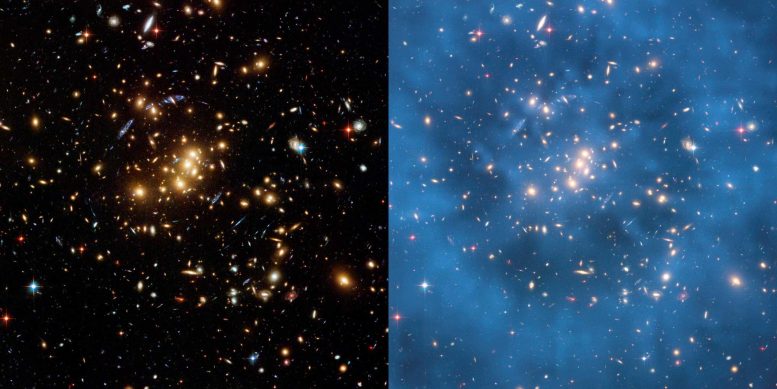
Galaxy cluster, left, with ring of dark matter visible, right. Credit: NASA, ESA, M. J. Jee and H. Ford (Johns Hopkins University)
Explorations in dark matter are advancing with new experimental techniques designed to detect axions, leveraging advanced technology and interdisciplinary collaboration to uncover the secrets of this elusive component of the cosmos.
A ghost is haunting our universe. This has been known in astronomy and cosmology for decades. Observations suggest that about 85% of all the matter in the universe is mysterious and invisible. These two qualities are reflected in its name: dark matter.
Several experiments have aimed to unveil what it’s made of, but despite decades of searching, scientists have come up short. Now our new experiment, under construction at Yale University in the US, is offering a new tactic.
Dark matter has been around the universe since the beginning of time, pulling stars and galaxies together. Invisible and subtle, it doesn’t seem to interact with light or any other kind of matter. In fact, it has to be something completely new.
The standard model of particle physics is incomplete, and this is a problem. We have to look for new fundamental particles. Surprisingly, the same flaws of the standard model give precious hints on where they may hide.
The Trouble With the Neutron
Let’s take the neutron, for instance. It makes up the atomic nucleus along with the proton. Despite being neutral overall, the theory states that it it made up of three charged constituent particles called quarks. Because of this, we would expect some parts of the neutron to be charged positively and others negatively –this would mean it was having what physicists call an electric dipole moment.
Yet, many attempts to measure it have come with the same outcome: it is too small to be detected. Another ghost. And we are not talking about instrumental inadequacies, but a parameter that has to be smaller than one part in ten billion. It is so tiny that people wonder if it could be zero altogether.
In physics, however, the mathematical zero is always a strong statement. In the late 70s, particle physicists Roberto Peccei and Helen Quinn (and later, Frank Wilczek and Steven Weinberg) tried to accommodate theory and evidence.
They suggested that, maybe, the parameter is not zero. Rather it is a dynamical quantity that slowly lost its charge, evolving to zero, after the Big Bang. Theoretical calculations show that, if such an event happened, it must have left behind a multitude of light, sneaky particles.
These were dubbed “axions” after a detergent brand because they could “clear up” the neutron problem. And even more. If axions were created in the early universe, they have been hanging around since then. Most importantly, their properties check all the boxes expected for dark matter. For these reasons, axions have become one of the favorite candidate particles for dark matter.
Axions would only interact with other particles weakly. However, this means they would still interact a bit. The invisible axions could even transform into ordinary particles, including – ironically – photons, the very essence of light. This may happen in particular circumstances, like in the presence of a magnetic field. This is a godsend for experimental physicists.
Experimental Design
Many experiments are trying to evoke the axion-ghost in the controlled environment of a lab. Some aim to convert light into axions, for instance, and then axions back into light on the other side of a wall.
At present, the most sensitive approach targets the halo of dark matter permeating the galaxy (and consequently, Earth) with a device called a haloscope. It is a conductive cavity immersed in a strong magnetic field; the former captures the dark matter surrounding us (assuming it is axions), while the latter induces the conversion into light. The result is an electromagnetic signal appearing inside the cavity, oscillating with a characteristic frequency depending on the axion mass.
The system works like a receiving radio. It needs to be properly adjusted to intercept the frequency we are interested in. Practically, the dimensions of the cavity are changed to accommodate different characteristic frequencies. If the frequencies of the axion and the cavity do not match, it is just like tuning a radio on the wrong channel.
Unfortunately, the channel we are looking for cannot be predicted in advance. We have no choice but to scan all the potential frequencies. It is like picking a radio station in a sea of white noise – a needle in a haystack – with an old radio that needs to be bigger or smaller every time we turn the frequency knob.
Yet, those are not the only challenges. Cosmology points to tens of gigahertz as the latest, promising frontier for axion search. As higher frequencies require smaller cavities, exploring that region would require cavities too small to capture a meaningful amount of signal.
New experiments are trying to find alternative paths. Our Axion Longitudinal Plasma Haloscope (Alpha) experiment uses a new concept of cavity based on metamaterials.
Metamaterials are composite materials with global properties that differ from their constituents – they are more than the sum of their parts. A cavity filled with conductive rods gets a characteristic frequency as if it were one million times smaller, while barely changing its volume. That is exactly what we need. Plus, the rods provide a built-in, easy-adjustable tuning system.
We are currently building the setup, which will be ready to take data in a few years. The technology is promising. Its development is the result of the collaboration among solid-state physicists, electrical engineers, particle physicists, and even mathematicians.
Despite being so elusive, axions are fuelling progress that no ghost will ever take away.
Written by Andrea Gallo Rosso, Postdoctoral Fellow of Physics, Stockholm University.
Adapted from an article originally published in The Conversation.![]()










Dark matter doesn’t exist, so good luck finding it.
Quantum physicists are making the folks who are looking for the Ark of the Covenant look less foolish in comparison.
If universes expand and expand. Black holes slowly evaporate over incomprehensible amount of time. Is it not possible that what we are seeing is that as our universe expands through space there is a background from previous universes that have existed? Causing peaks and troughs in a spacetime effect left over from such universes. I.e. such entities would exist well beyond the lifetime of the universes that once existed before in those regions. So space not just being space but a previously used and reused canvas. Such entities being too small to detect apart from the influence on our universes movement / development and interactions with it as it expands.
The mass of axions derived from neutrons would be wholly insufficient to explain dark matter. As they are, by definition, a very light component of the neutron.
To explain the quantity of dark matter the quantity of neutrons in the history would have to have inordinately enormous. Could axions themselves have been created in the Big Bang ? Is there any mechanism in theory for these hypotheses ? Is there any proof yet found ?
HEP (big collider grant inertia) physicists and Astro (big telescope grant inertia) are working together based on the notion that GR helps to detect something invisible and of low energy, versus the notion that GR physicists are hiding something invisible and low energy.
MOND is just there to help GR by purposefully failing to explain lensing blamed on DM and to give the impression all the best theoretical bases have been covered including blaming gravity.
There’s never going to be any support for the popular media idea that gravitons have positive mass.
There’s never going to be any support for the popular media assumption that gravitons quantize same as light (light is positive energy, size compression equates to energy compression).
There’s never going to be any support for GR in cosmology without DM faithfully imagined as more than a non-GR gravitational effect.
There will be more global politics posing as cosmological GR supremacy, no light-like particle expressing gravity carrying angular moment longitudinally (in other words at a right angle to all possible light rotations) as ultra-slowly rotating vector potentials with micro-tensor expression in collapse, probably not until some significant inevitable changes happen first. Just trying to be constructive here.
A photon has zero mass as the EM field vector rotates perpendicular to the photon’s path of progress. A photon advances in “flat” space carrying a predetermined helical field vector rotation pattern. The orthogonal (longitudinal) field rotation space is not exploited there.
A particle resembling light energy, but using a longitudinal rotation space, apparently requires dropping the notion that negative energy and positive energy don’t mix (without catastrophic result), requiring a large but ultimately limited amount of inherent vacuum positive/negative energy mixing, down to Planck scale. The so-called Planck mass (about the same as a flea egg) could conceivably be a balanced positive component for such a zero-rest-mass particle, for example.
“(D)ropping the notion that negative energy and positive energy don’t mix” much like the notion of a lightspeed particle with tachyonic potential. By that I mean the oscillating field of a photon, expressed by its helical pattern, appears stationary in the moving frame of the photon. Longitudinal oscillations, in complete contrast, must occur even in the frame of motion, but all of this can be conveyed, at any oscillation rate, by a particle existing at Planck scale, but only if one stops pretending light and gravity must quantize exactly the same way. The only obvious thing the two field carriers have in common is that faster field rotation rate requires more energy. Such net-massless gravity carriers could be said to have imaginary mass, mathematically speaking, but there’s comparatively nothing abstract about it at all, it’s only as complicated as it needs to be to obviate the DM effect through a correct vision of gravity instead of GR.
If we have confirmed the existence of dark matter, then yay!
Otherwise, this article is quite misleading, especially claiming to have an image of dark matter.
Oh, dark matter, the cosmic clown that’s had astronomers chuckling for a century, and there’s still no sign of a punchline that makes sense. It’s like they’ve been on an intergalactic wild goose chase for a hundred years, and all they’ve got to show for it is a bunch of cosmic whoopee cushions that keep deflating when they sit on them.
Now, enter axions, the absurdity’s absurdity. Astronomers, in their never-ending quest to turn the universe into a comedy show, have introduced these quirky particles into the cosmic script. It’s as if they’ve decided to juggle flaming bowling pins while riding a unicycle on a tightrope that’s on fire – you know, just to make the whole thing even more ridiculous.
Picture this: Astronomers, with telescopes pointed at the void, staring blankly at the cosmic canvas, suddenly shout, “Dark matter, axions, and…um, other stuff, I guess?” as if they’re naming random things from their grocery list and hoping it will magically make sense. It’s like trying to play chess with a set of Scrabble tiles – chaotic and utterly incoherent.
They’ve essentially turned the pursuit of knowledge into a century-long cosmic slapstick routine, where the punchline is eternally delayed, and dark matter is the banana peel that keeps astronomers slipping. Axions, in this carnival of chaos, are the cotton candy that’s been flung into the crowd, sticking to everyone and making everything even stickier.
So, here’s to our persistent astronomers, who’ve transformed the cosmos into a never-ending cosmic stand-up show, with dark matter as the bumbling, pratfall-prone comedian. Keep the popcorn handy, folks; this spectacle of cosmic confusion shows no sign of a sensible ending anytime soon.
The science of Astronomy has been turned into pseudoscience and brought into disrepute on the same level as astrology no doubt to keep the funding coming in from the gullible funders of such foolishness.
Look at it. Whimps. machos. dark ions. dark sectors. dark matter. dark energy. dark tension. axions.
dark flow. dark uranus…
Disgraceful.
Could dark mater be simply composed of photon pairs? Identical in all parameters but phase shifted 180 degrees from each other. This would make them undetectable.
Axions are theoretical, as are WIMPs. Dark Matter exists. To see what it is, check out this YouTube, “Dark Matter – A String Theory Way”.
Sounds good, Like translucent water if you add a die it reveals itself.
it’s basically impossible to find visual depictions of individual galactic “halos” (ambiguous term which may imply a ring effect for many readers), only galactic clusters are shown where the ordinary matter and DM can be separately distinguished by using separate colors, where the individual galaxies are nearly dot-sized and dot-shaped.
Also It would be helpful to see more articles on the Dark Matter effect in elliptical galaxies. Ellipticals seem too energetic and chaotic to show a clear ring structure in any DM effect. There are discussions online mentioning hydrogen rings around ellipticals and DM effect halos, but no clear mention or images of rings in any DM effect structure for any one detailed galaxy. At one point it seemed to me “shell” structures in ellipticals could be saying something about DM, but apparently after looking at a simulation it looks as if no DM effect is needed there, and GR without DM probably suffices for adequate simulations of colliding compact galaxies periodically clashing to generate shell patterns.
The word “effect” is added here to avoid ruling out GR inadequacy as the cause of “Dark Matter” detection, aiming for an honest and unbiased placeholder term.
Modern science seems to have invested quite heavily in the concept of virtual particles and now axions, which are also apparently virtual particles. In fact, the Standard Model theory for the propagation of electromagnetic radiation as epitomized in second quantisation is based almost exclusively on virtual particles. An electron in an antenna emits a photon, that photon undergoes spontaneous self-annihilation giving birth to an electron-positron pair which, since they constitute matter and anti-matter immediately experience mutual self-annihilation giving rise (wait for it) to a photon identical to the original photon that had undergone self-annihilation. During this process they also have direction and travel at the speed of light. All this takes unimaginable amounts of energy, 1.02 MeV for each annihilation and creation process. Since quantum mechanics depends so heavily on virtual interactions it is strange that the implications of the Lamb shift have been completely ignored. The Lamb shift is an experiment that offers empirical proof that electrons in atoms are constantly undergoing virtual interactions. The electron as it travels around the atom is constantly emitting and absorbing virtual photons. Consider the implications, it means in effect that the electron is self-regulating its energy and cannot possibly fall into the nucleus, which was the original reason for the introduction of wave particle duality. The quantum mechanics waffling that these virtual particles are only emitted by valence electrons, is completely unjustified. This means that if wave-particle duality is wrong, Schrodinger’s equation with its multiple dimensions is wrong and wave functions are wrong. In fact, the whole precarious structure falls down.
Beta-decay of free unstable neutrons creates stable protons that can attract an external electron to form simple hydrogen atoms. Since neutrons have a mass equal to 1,836 electrons, it’s constituent 918 beta-pairs act as stable “threshold” gammarays (1.0216 Mev) which require a specific field to decay as electron-positron “pair-formation”. This is the same as beta-decay, and presumably occurs from resonant helicital discharges within the unstable neutron. Only one beta-pair needs to decay to create a stable proton, by emitting a free electron while sharing the positronic component to provide the +1 charge of the proton. See pair-formation at http://www.PhotonStructure.com
The mesmerizing nature of the empirical observations of the result of the decay of neutrons and of the intricate interatomic processes that take place in the transformation of elements, is undeniable. However, one has to consider if, such a theory as that put forward by the Standard Model for the propagation of light which depends on creation and annihilation processes, to explain the propagation of light and electromagnetic radiation, is feasible: (a) because of the incredible amounts of energy involved (1.02 MeV) for each creation and annihilation process used in this process (b) because so much on the nature of light (i.e., its rectilinear propagation, its following of the inverse square law, the maintaining of its energy intact over huge distances) is left unexplained by such a theory. The crowning achievement(!) of such a theory is that it ends with the same mathematical results arrived at by the use of Maxwell’s equations. The logical deduction of this line of thought is that simpler concepts have been left unexplained while claims are made on the cosmological scale. Take for instance the electron in the atom. Present theory would have one believe that the electron exists in the atom as a cloud or wave. When a photon (another wave) enters the atom it in some unexplained way interacts with the electron cloud. Take the dimensions of the photon into consideration, a 500 nm photon is 168 million times the size of the classical electron radius and 5000 time the size of an average atom. No explanation is offered as to what takes place. Classical concepts of energy conservation are ignored. The electron cloud subtracts energy from the incoming photon, in some unfathomable manner and moves to a higher energy level, when the electron cloud drops from the higher energy level to its original energy level it emits a wave with the exact original energy of the incoming wave (photon). Amazingly enough, a return to the much maligned aether theory (what else could Dark Matter be?), gives all of the answers, including those to do with gravity.) Please Read:
https://fdrive.cloud/drive/s/I0SVk1PXkFZbuJpglGL4YcNEpDJ0SN